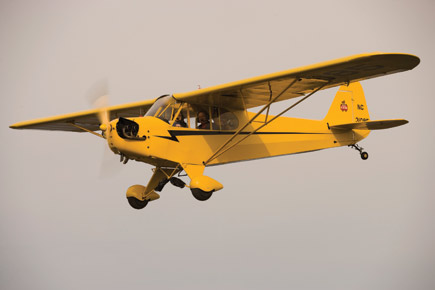May 20
Pan American Airways begins trans-Atlantic mail service with its Yankee Clipper Boeing 314 out of Port Washington, New York, to Lisbon and >Marseille.
Twentieth anniversary of Lindbergh’s solo flight from New York to Parisis celebrated on “Aviation Day” at the New York World’s Fair.
May 30
Wilbur Shaw wins Indianapolis 500 with a speed of 115 miles per hour.
Airplanes of 1939 sharing the same birth dates
By Alton K. Marsh
 Cub: Sentimental Journey to Ponca City?
Cub: Sentimental Journey to Ponca City?
Every year pilots remember the Piper Cub by traveling to the former factory at Lock Haven, Pennsylvania. Piper Aircraft Corporation sold J–3 Cubs there starting in 1937 out of an abandoned silk mill, where Cub production remained through World War II. Nearly 6,000 Cubs were built for civilian training or military use. On July 8, 1946, Cub production was moved to Ponca City, Oklahoma, where it remained until 1948—when the general aviation boom went bust. Those built there had special data plates indicating they were built there. Buildings remain at Ponca City where Cub production was done, so why no journey? While AOPA is having a seventy-fifth anniversary this year, guess what else has the same anniversary? The Piper J–4 Cub Coupe with side-by-side seating was built in 1938 but introduced to the aviation world in 1939. Happy anniversary, J–4.
Email alton.marsh@aopa.org
Staggerwing
By 1939 the Beechcraft Staggerwing was going strong, then in its seventh year of production and much sought after by business executives. At 200 miles per hour, it was faster than military pursuit aircraft at first, although that was no longer true by 1939. That year the hottest pursuit plane was the experimental Lockheed P–38 that crossed the United States in February 1939, only a month after it first flew, at nearly 400 miles per hour. It tangled landing gear in some trees approaching the final destination on Long Island and crashed, but the pilot was not injured. It had taken 18 months to build the aircraft.
Bamboo Bomber
Military flight students named Cessna’s twin engine T–50, the commercial version of the AT–17 Bobcat, the Bamboo Bomber because it was made of wood, although not bamboo. It first flew on March 26, 1939, and was intended as a business airplane for customers who couldn’t afford the faster Beechcraft Model 18 Twin Beech. Military sales brought the total made to 5,400. It was the first airplane used on the television series, Sky King.
Pilot Products
SiriusXM Aviation weather receiver
New weather information offered
By Alton K. Marsh
 You’re seeing the tip of the iceberg with the introduction by Garmin of the $599 GXM 42 SiriusXM weather receiver. Sure, you’ll get cloud-to-cloud lightning with the new antenna, but that’s half of the story.
You’re seeing the tip of the iceberg with the introduction by Garmin of the $599 GXM 42 SiriusXM weather receiver. Sure, you’ll get cloud-to-cloud lightning with the new antenna, but that’s half of the story.
The XM weather folks have created a much better satellite signal that brings all sorts of new weather information. It requires a new antenna—not the one you got in the box free when you bought your Garmin aera 796 portable GPS. The old signal can continue to be used for years, but if you want the new services, you’ll need the new antenna. For now the GXM 42 only works on the aera 796, and with it comes a software upgrade that makes the 796 smart enough to receive the better signals. In the future the GXM 42 will be available for the 696 and 500-series GPS portable units as well (but probably never for the 496 and 396 units). The old signal will die sometime in the distant future on a date to be determined by SiriusXM.
“Garmin has developed the new GXM 42 SXM weather/music receiver to support this new signal and the new SXM aviation weather subscriptions offered for this service,” Garmin said. “Garmin plans to offer an upgrade path to the GXM 42 SXM weather/music receiver for the XM WX capable portables currently in production, including the aera 796 [available now using latest released V4.01 software], GPSMAP 696, and aera 510/560. All of these models will use the GXM 42 SXM receiver when software is available.”
The plan is to sell future aera 796 units without the antenna for $1,699 (Sporty’s sells them with an XM WX antenna, but not a free weather subscription, for $1,999). SiriusXM is expected to offer a $300 SiriusXM Rewards Visa Prepaid Card rebate for new purchases. Activation fees have been lowered to $25 and discounts are available to customers who prepay for annual subscriptions with SiriusXM. The base subscription service now includes lightning, including cloud-to-cloud and cloud-to-ground activity; graphical winds aloft; temperatures aloft; airmets and sigmets—previously available only in higher priced subscriptions.
Price: $599
Contact: www.garmin.com; www.siriusxm.com/sxmaviation
Email alton.marsh@aopa.org
How it used to be done
There were 88 airports with 24-hour weather stations staffed only by Weather Bureau personnel providing briefings to pilots in 1939. Weather maps were prepared based on observations of 171 weather stations using teletype to report findings. The 165 weather stations located on airways used a telegraph to send reports for the clearance of scheduled flights.
College Park vs. Pearson Field
Oldest airport debate flies on
By Alton K. Marsh
Debate rages—maybe simmers is a better word—as to which airport is the oldest in the United States. While many make the claim worldwide, the battle comes down to two: College Park Airport, Maryland, and Pearson Field in Vancouver, Washington.
For Jane Welsh, director of the College Park Aviation Museum, the answer is simple; the Wright brothers came to College Park to teach the U.S. Army to fly their airplanes in 1909, making it the nation’s “oldest continuously operating airport.”
For Clu Scott, who calls himself the “counter janitor” at Aero Maintenance Flight Center at Pearson Field, the answer is simple. Eighteen-year-old Lincoln Beachy landed a dirigible called Gelatine (that first aerial advertisement for Knox Gelatine) at the Vancouver Barracks polo field, later to become Pearson Army Field and then just Pearson Field, in 1905. Air mail was involved as well, since he delivered a letter to the barracks commander. “I think we were here first,” Scott said.
Just a minute there, says Welsh. That was a dirigible, not an airplane. Then she adds, there is the matter of continuous operation. While a home builder tried to fly from that same polo field in 1911, it wasn’t until 1912 that an airplane actually made it into the air. Until 1911, not much aviating occurred there.
If you want to get technical, says Pearson airport manager Willy Williamson, Kll Devil Hill was first; Huffman Prairie Flying Field at Dayton, Ohio, where the Wrights tested airplanes is second; and then comes Pearson and College Park.
“If you are talking about fixed wing, then College Park has us beat by a year. If you are talking about aviation overall, then we have them beat,” said Williamson. That almost settles it, until Williamson adds, “The air mail counts.” Sounds like debate is still open.
Email alton.marsh@aopa.org
This just in; College Park wins!
“College Park continues to be the oldest,” says Greg Shine, a chief ranger and historian for the National Park Service near Pearson Field. The NPS owns half the land where the airport is located, while the City of Vancouver owns the remaining land, said Laureano Mier, director of aviation education at the Fort Vancouver National Trust’s Pearson Field Education Center. Pearson Field became part of the Army Air Service only in 1923, and wasn’t named Pearson Field until 1925. During World War II it was home to a sawmill that cut up spruce trees to make airplanes; airplanes operated there continuously, he said.
Famous Women Pilots: Who was first?
Katharine Wright: Of his sister, Wilbur said, “If ever the world thinks of us in connection with aviation, it must remember our sister.”
Baroness de Laroche: First woman to earn a pilot certificate.
Bessica Raiche: First American woman to solo.
Harriet Quimby: First American woman to earn a pilot cerificate.
Katherine Stinson: First female airmail pilot and flight school owner.
Amelia Earhart: First woman to fly across the Atlantic.
Florence “pancho” Barnes: First female stunt pilot.
Jacqueline Cochran: First woman to break the sound barrier.
Geraldine “Gerrie” Mock: First woman to fly around the world.
Willa Brown: First African-American woman to earn a pilot certificate.
Hanna Reitsch: First female helicopter pilot.
Marion Jayne: First female world-record holder for the most cross-country speed race victories.
Anne Morrow Lindbergh: First American woman to earn a glider pilot certificate.
Volunteers Needed!
The AOPA Fly-in at San Marcos, Texas, on April 26 needs volunteers. Please visit the website to register if you will be in the area. Other fly-ins will need help too, so check the website regularly.
This month on the AOPA Jay
 New scenarios on the AOPA Jay
New scenarios on the AOPA Jay
Sun ’n Fun Arrival: If you didn’t make it to Lakeland this year there’s still time to fly in to Sun ‘n Fun—on your AOPA Jay. Fly the Lake Parker VFR Arrival in a Cessna 172. Follow ATC instructions carefully to join the arrival, and watch for other aircraft. Do everything correctly and you’ll see for yourself why getting there is half the fun!
Dead Reckoning: Airmail in the ‘20s: Do you have what it took to be a pioneering airmail pilot back in 1921? Having been forced down by a passing squall at an emergency landing strip in Sunbury, Pennsylvania, you’re now ready to tackle the last and most dangerous part of the first leg of the transcontinental airmail route in your Curtiss JN–4 Jenny biplane. With nothing but your dead reckoning and pilotage skills to guide you (and your frayed wits to keep you company), you head west across the infamous “Hell Stretch” over the Allegheny Mountains. Can you find Bellefonte?
Don’t have your AOPA Jay yet? Find out more online.
Aerial taxicabs
A concept from 1947
By Alton K. Marsh
A current dream by visionaries today to fill the skies with aerial taxicabs is not that different from a dream of Piper Aircraft in 1947 when the Taxicub service began to fly. AOPA Pilot founder Max Karant was the first in the Chicago area to use the service. The idea then was to link small airports to larger ones, while today’s dream is to replace airlines with small but speedy aircraft that can be hailed from the sky with three days notice.
Taxicub was operated by Piper’s 1,500 dealers at the time, plus 52 regional distributors. Karant rode a Cub from Elmhurst Airport to what is today Chicago Midway International Airport. Elmhurst Airport existed until 1956 when it was sold to become an industrial park. A Chicago newspaper reported that Karant paid 12 cents a mile for his trip through the Chicago area for a total cost of $12. The aircraft used was a three-passenger Piper Super Cruiser. “The ships have two-way radios,” one enthusiastic newspaper report said.
The aircraft carried the name “Piper Taxicub” on the fuselage. Ads showed happy businessmen with briefcases talking with the pilot, who was the Piper dealer dressed in a captain’s uniform. “If you have a pilot’s license, he will rent you a Piper Taxicub to fly yourself,” the ad said. When founded at Lock Haven, Pennsylvania, the goal was to fly passengers for six cents a mile, a price that was later raised.
Email alton.marsh@aopa.org
Fantasy of Flight closes
Plans to return with wider appeal
By Benét J. Wilson
 Polk City, Florida-based Fantasy of Flight aircraft museum was scheduled to close to the public April 6, after owner Kermit Weeks said it failed to sustain itself. The $30 million attraction opened in 1995. Weeks said he plans to focus on Fantasy of Flight’s private event business and the design and development of a future destination attraction.
Polk City, Florida-based Fantasy of Flight aircraft museum was scheduled to close to the public April 6, after owner Kermit Weeks said it failed to sustain itself. The $30 million attraction opened in 1995. Weeks said he plans to focus on Fantasy of Flight’s private event business and the design and development of a future destination attraction.
“Although we are located just 20 minutes west of Walt Disney World, we’re currently outside the center of mass tourism and not perceived of as a destination. We have a great product, but people have a misperception of what we offer,” said Weeks. “After 18 years of being in operation, it’s time we close the attraction and move forward toward creating the vision for what I know Fantasy of Flight can become.”
Weeks said that along with continuing the events business, including weddings, meetings, and corporate events, he will turn the facility into what it was originally designed for: a restoration and maintenance facility that will be needed to build future attraction elements. There are plans to open part of the collection to the public for paid admission later in 2014.
“This isn’t the end of Fantasy of Flight, it’s just the next step on the company’s journey to become what it was always meant to be—a quality attraction that uses entertainment as a means to an end for self-discovery and self-transformation,” said Weeks. A report in the Orlando Sentinel speculated that the new attraction—to appear in three, five, or more years—will appeal to a wider audience than just aviation buffs.
Email benet.wilson@aopa.org
Video: On YouTube search “Crossroadofadream:KermitWeeks”
 AOPA’s efforts to protect, defend, and promote general aviation have continued since its inception in 1939. Over the past 75 years, the association has won many battles, ensuring that general aviation in this country is one of its freedoms. AOPA continues to advance the concerns of general aviation pilots and will celebrate its seventy-fifth anniversary during its planned six AOPA Fly-Ins across the country this year, with a special emphasis on the anniversary at the Frederick, Maryland, homecoming fly-in October 4, 2014 at the association’s headquarters.
AOPA’s efforts to protect, defend, and promote general aviation have continued since its inception in 1939. Over the past 75 years, the association has won many battles, ensuring that general aviation in this country is one of its freedoms. AOPA continues to advance the concerns of general aviation pilots and will celebrate its seventy-fifth anniversary during its planned six AOPA Fly-Ins across the country this year, with a special emphasis on the anniversary at the Frederick, Maryland, homecoming fly-in October 4, 2014 at the association’s headquarters. 


